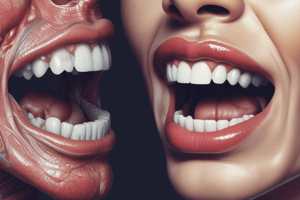Podcast
Questions and Answers
What is the primary action of the Mylohyoid muscle?
What is the primary action of the Mylohyoid muscle?
- Elevates the floor of the mouth (correct)
- Depresses the tongue
- Pulls the hyoid bone anteriorly
- Flexes the jaw
Which nerve innervates the Hypoglossus muscle?
Which nerve innervates the Hypoglossus muscle?
- Facial nerve
- Vagus nerve
- Trigeminal nerve
- Hypoglossal nerve (correct)
Which structure is lined with non keratinized stratified squamous epithelium?
Which structure is lined with non keratinized stratified squamous epithelium?
- Hard Palate
- Alveolar bone
- Soft Palate (correct)
- Gums
What type of mucosa does the Hard Palate have?
What type of mucosa does the Hard Palate have?
What is the primary arterial supply for the Geniohyoid muscle?
What is the primary arterial supply for the Geniohyoid muscle?
Which of the following muscles assists in swallowing?
Which of the following muscles assists in swallowing?
The lamina propria in the form has what characteristics?
The lamina propria in the form has what characteristics?
What is a common clinical appearance associated with the form?
What is a common clinical appearance associated with the form?
Flashcards are hidden until you start studying
Study Notes
Muscles of the Floor of the Mouth (FOM)
- Mylohyoid: Elevates the floor of the mouth and the hyoid bone during swallowing. It originates from the mylohyoid line of the mandible and the body of the hyoid bone. It is innervated by the mylohyoid nerve, a branch of the trigeminal nerve (CN V3), and receives blood supply from the sublingual and facial arteries.
- Hypoglossus: Depresses the tongue. It originates from the body and greater sides of the tongue and is innervated by the hypoglossal nerve. It receives blood supply from the lingual artery.
- Geniohyoid: Pulls the hyoid bone anteriorly and superiorly, assisting in swallowing. It originates from the inferior mental spine of the mandible and inserts into the body of the hyoid bone. It is innervated by the first cervical nerve (C1) via the hypoglossal nerve and receives blood supply from the sublingual artery.
Histological Structure of the Oral Cavity
- Floor of Mouth: Exhibits a smooth, moist surface, may have sublingual papillae, and may show sialoliths (salivary stones). It is classified as lining mucosa with non-keratinized stratified squamous epithelium. The lamina propria consists of loose connective tissue with glands (sublingual and submandibular glands). The submucosa contains minor salivary glands and loose connective tissue without significant fat.
- Hard Palate: Displays a firm and keratinized surface with palatine rugae (ridges of mucous membrane). It is classified as masticatory mucosa with keratinized stratified squamous epithelium. The lamina propria is dense and regular connective tissue, referred to as palatine bone. The submucosa is thin and may contain salivary glands (palatine glands).
- Soft Palate: Shows a soft, flexible surface with the uvula and mucous gland openings. It is classified as lining mucosa with non-keratinized stratified squamous epithelium. The lamina propria consists of loose connective tissue with more elastic fibers. The submucosa contains muscle and more prominent minor salivary glands.
Studying That Suits You
Use AI to generate personalized quizzes and flashcards to suit your learning preferences.




